Write Us
We are just a call away
[ LET’S TALK AI ]
X
Discover AI-
Powered Solutions
Get ready to explore cutting-edge AI technologies that can transform your workflow!


Nowadays, digital transformation is vital to remaining competitive in an ever-fastening business climate, and this cannot be neglected. Digital technology’s evolution has been fast in many companies. Due to the rapid advancements within areas like artificial intelligence, businesses will likely require further adaptation. However, navigating through many technological advances while overseeing an entire organization and its staff can make it challenging to implement the new procedures effectively.
It is good that implementing a well-established digital transformation framework can help companies implement their digital transformations more efficiently by aligning their digital efforts to specific business goals. Businesses must take advantage of the digital revolution. Regardless of the industry, market conditions constantly evolve in response to new technology. Digital transformation helps companies better prepare to face digital disruptions of the near future.
To ensure the success of digital transformation, a radical change in the leadership perspective and organizational culture is necessary. However, most companies cannot afford this massive shift at once. They must be aware of which elements of digital transformation will require the most significant transformation. Every company must prioritize changes based on business goals as part of its strategy planning process.
This blog offers a complete overview of digital transformation frameworks, which are essential devices for firms seeking to succeed in the new digital world.
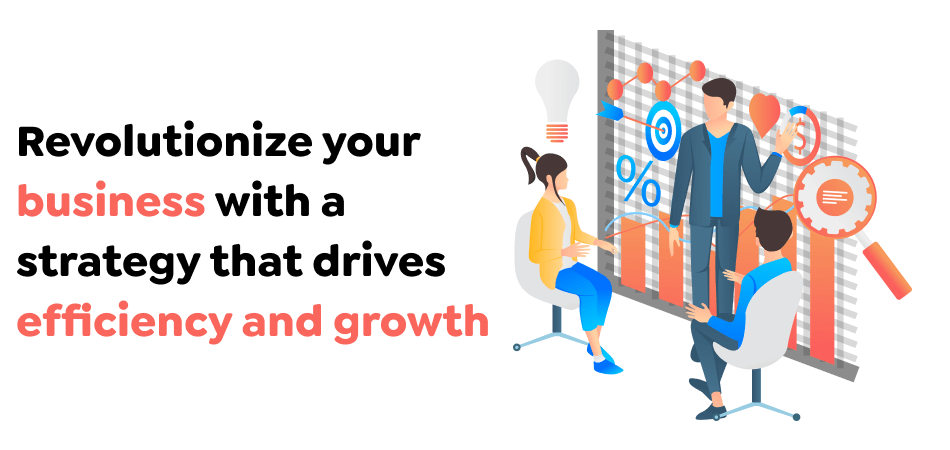
The digital transformation framework is a strategy that helps companies rethink how they work to facilitate massive technological and cultural change. By focusing on driving the development of technology and organizational structures and growth, this plan seeks to increase the efficiency of value creation, productivity, and operational efficiency. Digital transformation is generally a long-term plan that outlines how an organization will tackle the many complex challenges of entering a digital era.
When you know what you’re doing in this process, the next step is to think about improving your work. For instance, suppose you’re using an automated email system to improve customer relations and create trust with your brand. However, you’re evaluating the effectiveness of your change with the old KPIs. The same outcomes measured with a different system don’t necessarily mean you get more outcomes.
For success in the digital transformation process, organizations must communicate in a language everyone in the organization can understand. The programming language should be superior to any technology unique to the organization. It has to go right into the core of the process, the culture, and how individuals work and communicate. It is all achievable with the right digital transformation structure.
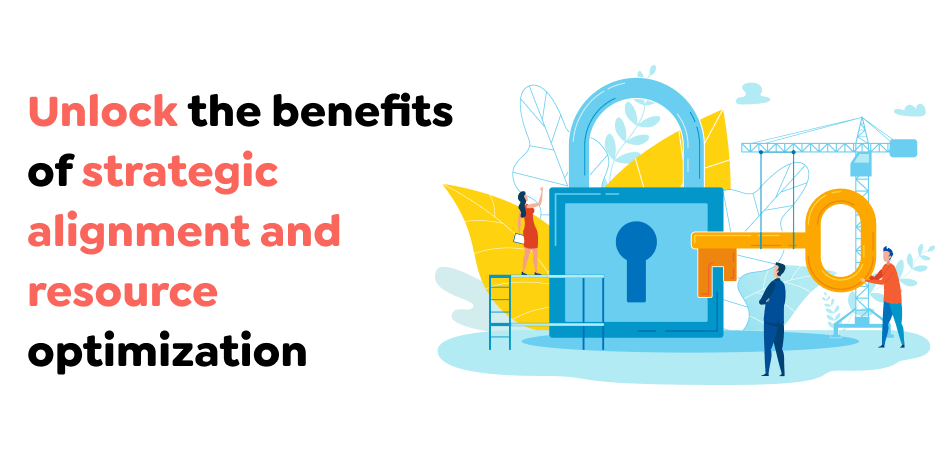
Digital transformation frameworks can provide many benefits to organizations, including helping to utilize areas that might not have been considered had the framework not been used. We have outlined these areas in the following paragraphs.
A digital transformation framework can ensure that projects implemented digitally meet overall company goals. This will ensure that investments in digital transformation within the business are geared towards achieving certain corporate goals rather than adopting the most recent digital trends, thereby increasing transformation efficiency. In addition, digital initiatives that don’t follow an established framework could lack direction and coordination, leading to wasted resources and lost opportunities for strategic technological advances.
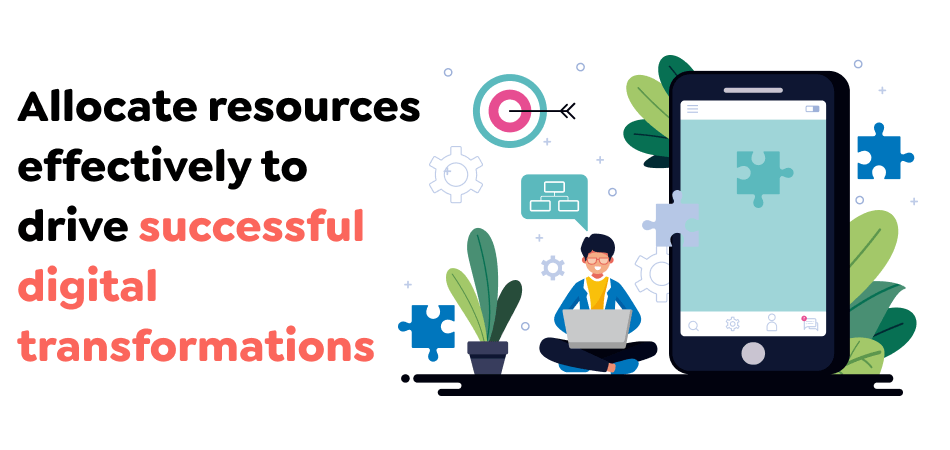
Achieving effective resource allocation could determine the success or failure of a complete digital transformation. Without a framework, businesses might struggle to allocate the right resources, which can lead to delays, budget overruns, and the possibility of canceling efforts to transform their digital environment.
Digital transformation frameworks help companies allocate their funds and resources to those areas most crucial to changing their app development company. They help reduce wasteful resources and increase the efficacy of the digital transformation process.
Implementing a digital transformation framework could be used as a guideline for transforming an organization. This is because it outlines the order of stages, milestones, and timeframes needed to reach transformation objectives. This clarifies everyone involved and helps ensure the most realistic and practical implementation of the new processes and software as well as the necessary education and reskilling courses. Organizations often find it difficult to implement successful digital programs for employees without a roadmap. This leads to an absence of organizational changes and a slow digital change.
Measuring the success of the digital transformation process is essential to making data-driven choices and ensuring that your digital efforts deliver value. An extensive framework for digital transformation includes essential indicators of performance (KPIs) and other indicators that your company can monitor to aid in assessing the results of your efforts to transform. Furthermore, monitoring these indicators will enable companies to determine the value of their investment and the internal impact of their newly implemented digital methods and adapt as necessary.
A transformation strategy must also include suggestions regarding how changes can be controlled during a company’s digital transformation to facilitate organizational transformation effectively. Digital transformation typically brings substantial changes to an organization’s processes and culture, which may cause internal resistance and even obstacles to accepting the chance.
The digital transformation framework offers guidelines on how changes will be efficiently communicated to employees and what innovative and modern technologies can address resistance to change. Without a solid digital transformation plan, companies may face internal resistance and problems adjusting to modern digital technologies that have been implemented.
Also Read – Into the Metaverse: Pioneering the Next Frontier in App Development
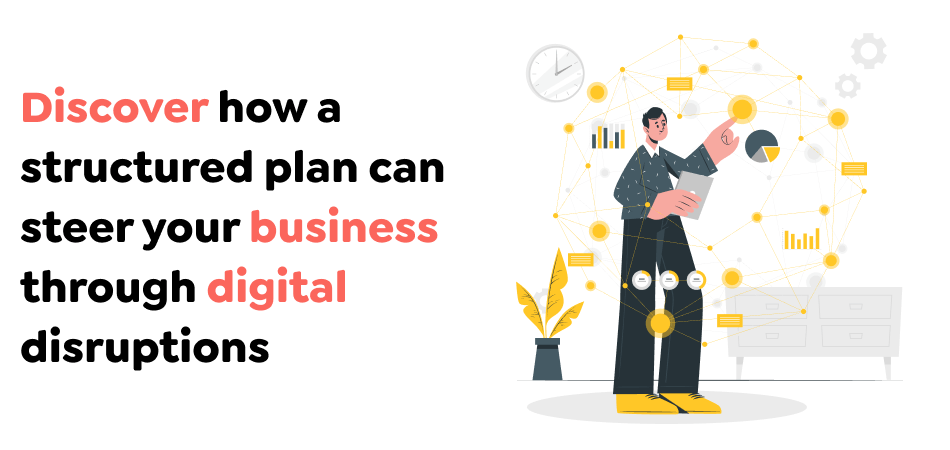
Large-scale transformation efforts often have an average failure rate of 70. The most common causes are insufficient leadership and inadequate cross-functional collaboration. However, a structured plan and implementation can assist companies in avoiding the pitfalls.
In today’s business environment, an effective Digital Transformation Framework is crucial. It is a guideline for navigating disruptions triggered by new technologies, which are external and can impact business processes. Digital transformation provides a unifying approach for the company and ensures that management and employees are in sync in their pursuits amidst changing marketplace app trends.
We will look at how a framework of digital transformation can help companies during turbulent moments:
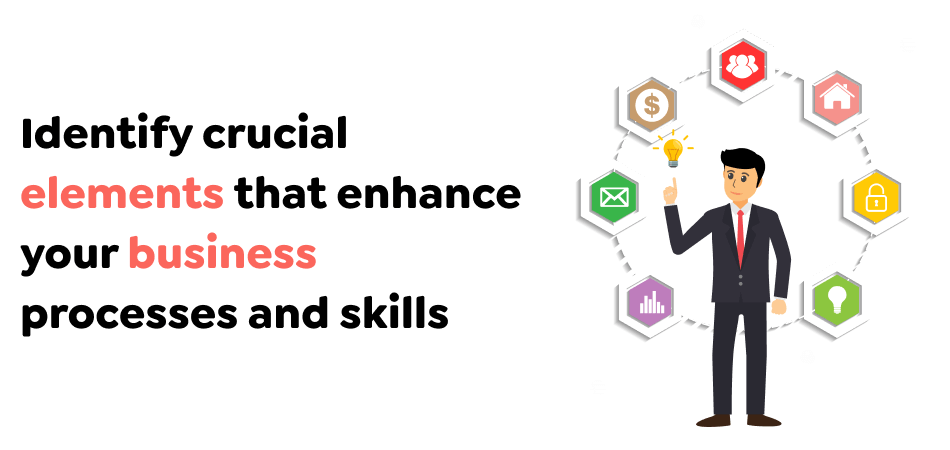
There are many features of digital transformation framework some of them are:
A robust digital transformation framework can help enhance critical business processes across the company. A solid framework has techniques and tools to assess the current process, allowing businesses to spot bottlenecks and areas for improvement. It ensures that projects to transform digitally aren’t restricted to specific departments in your company and have an overall impact on the company’s processes.
Any solid digital transformation framework must recognize the significance of “power skills” alongside technical abilities. “power skills” refers to soft abilities like communication, leadership, problem-solving, and flexibility, which are essential to every employee in an organization. They’re necessary to foster cooperation, help teams navigate transitions, and successfully utilize modern technologies, all of which are abilities that are essential to efficient digital change. To ensure that a robust digitization strategy frameworks should offer training and resources that assist employees in developing and acquiring the power of self- and organizational advancement.
Each business requires a digital transformation strategy compatible with its unique digital goals. So, a robust digital transformation strategy will contain a strategy for identifying the most appropriate technologies to meet the business model, internal needs, and client requirements. The framework will help your company continuously adapt its processes and software to meet customers’ changing demands and needs.
A key aspect of a good digital transformation framework is its focus on fostering a culture of continual learning and improvement. An effective framework will create the foundations for continuous education, knowledge sharing, and feedback loops to promote a culture of continuous development and help workers understand the benefits of continuous learning.
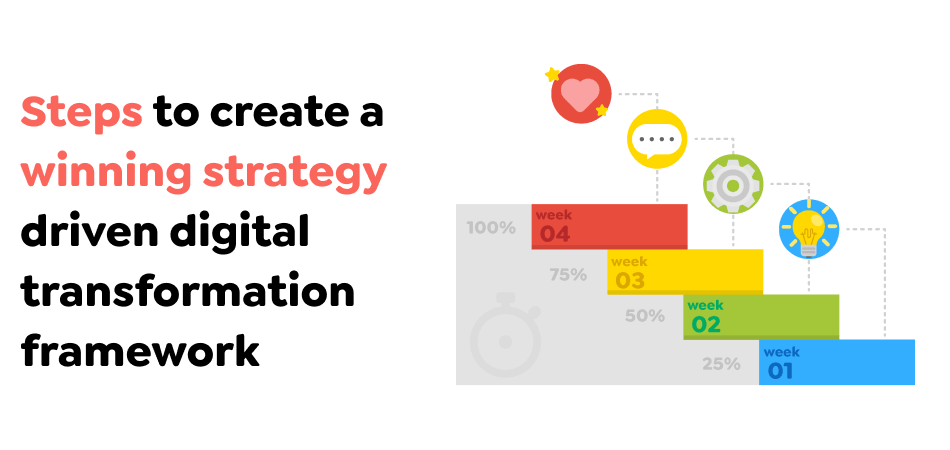
Here are some of the critical components to create a winning strategy-driven digital transformation framework
The goals you select should be both short-term and longer-term. The most fundamental goals of digital transformation are a more enjoyable customer experience and increased profits. One method to enhance your customers’ experience is to provide the customer with digital options. This is especially beneficial for industries like insurance and banking.
Besides providing a superior customer experience, getting digital products and services will also reduce costs. Another method to reduce expenses is to make your procedures more effective. Utilizing digital tools to make sure that repetitive procedures are automated. This makes it easier for employees to increase their productivity.
When you’ve set your objectives, it is time to develop a strategy to achieve them. One of the best ways to accomplish this is to break down each goal into small steps to make it easier to keep track of their achievement. This is the digital transformation plan. It is generally said that there are three routes you could choose from.
The initial step is using the latest technology to enhance the efficiency of your processes within the company and make them more effective. As we said earlier, this could help you reduce costs and increase your employees’ efficiency. A second option is focused on customers. If you’re already using electronic tools in your organization, you could extend the tools around to increase customer satisfaction. This could mean receiving client feedback, interfacing with them, or offering customized products and services.
Also Read – Navigating the Impact of IoT & Cloud Computing on Modern Technology
Another option combines the first two. The process will undoubtedly require some time and effort. But if you’ve got sufficient resources available, take the initiative to do the work!
Specific tools can help if you’re on the first route to digitalization (internally targeted); others can help those on the second (externally focused). Software like automated testing, analytics, and automation can improve the efficiency of your processes within your organization. Software such as chatbots can improve the customer experience.
Every change you make could be faster. There will be mistakes to make. Specific strategies you put into practice might not work in the beginning. That’s okay! Take the time to analyze the data you gather and gain from it. After you’ve decided on your digital transformation and strategy’s goals, follow it as strictly as you can. Don’t be frightened to change your mind if something doesn’t go as planned. So long as your method is focused on the action, you’ll succeed.
Although you may be working closely with technology, your “human” aspect is just as crucial. This is true not just for your customers but also for your employees. The process of change is not easy for everybody. Take a step back and feel empathy for the people who are part of your transition, and take the steps needed to help make it easier.
The success of implementing an effective digital transformation strategy depends not just on your goals and the technology you decide to employ. It’s also contingent on how your company’s leadership team guides employees through the digital transformation. Be sure that your digital transformation managers are aware of the framework’s human and technical elements.
It takes work to complete. As a digital manager, you are responsible for teaching your employees how to do it and motivating them to succeed even when they fail. To make it easier for you, contact consulting firms to help you develop your framework for digital transformation. You can also utilize the firms from whom you purchase the digital tools you need. They generally offer training for the products they sell and will aid employees who need to use them.
Also Read – AI Apps: Powering the Future of On-Demand Work
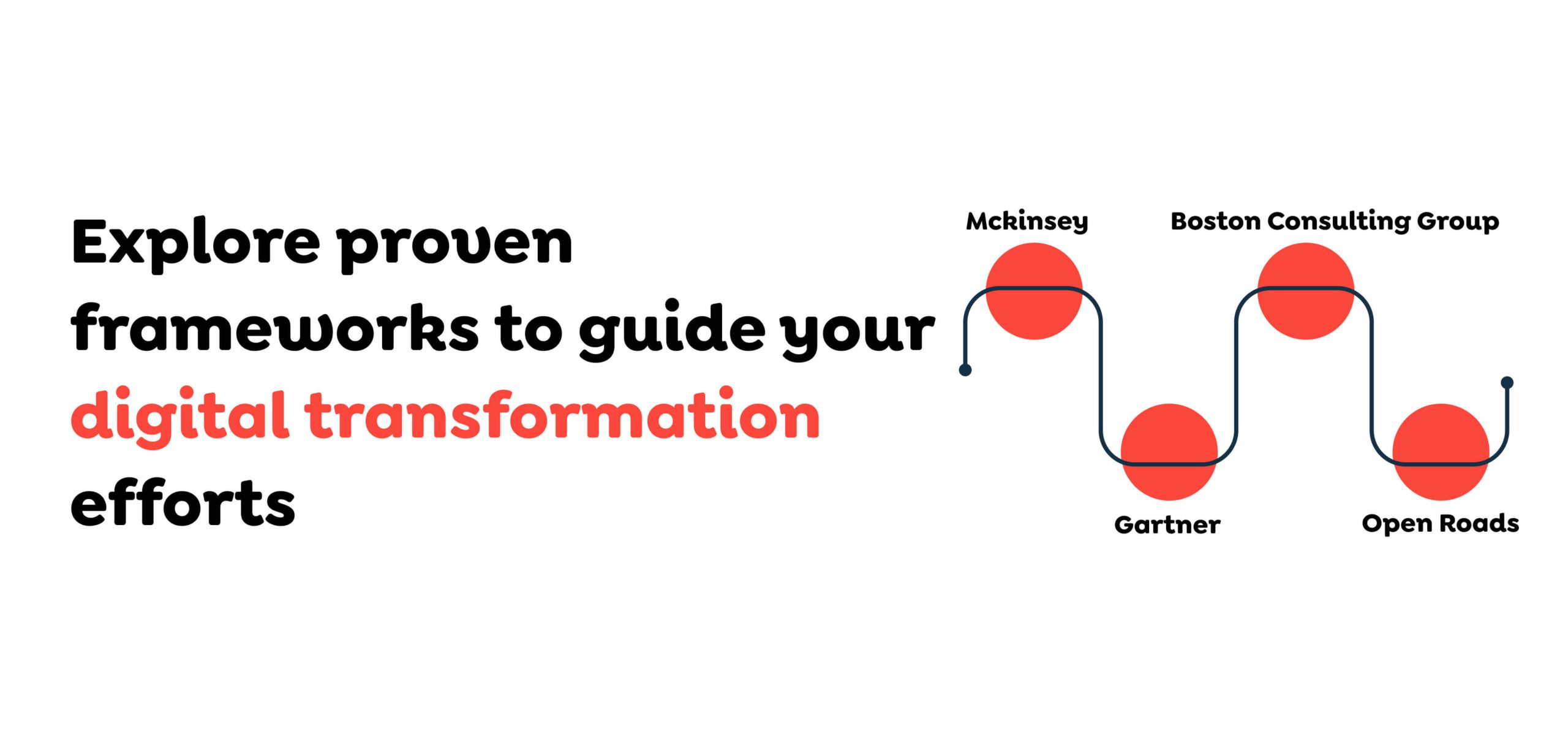
Let’s take a review of the various frameworks that offer digital transformation to consider when planning your DX task or select when you think they can aid you with your task:
McKinsey, a well-known consulting company, has designed an extensive and unique structure that can guide companies through the digital revolution, referred to by the 4Ds. The initial digital transformation process was built around four key elements: discovery and design delivery to reduce risk. At present, McKinsey has recently evolved the framework to encompass the design and data aspects and distribution, identifying the key components that lead to the success of digital transformation projects.
In addition, McKinsey offers a robust approach known as the Six Building Blocks to building a highly-performing Digital Enterprise.’ The strategic framework gives executives an organized and well-structured base to design and implement significant digital transformative changes. The six components encompass essential aspects, including the importance of strategy and innovation, recognizing the journey of a customer’s decision-making process, process automation, organization aligning, using appropriate trending technologies, and maximizing the power of analytics and data. By focusing on these essential elements, companies can effectively manage the challenges of digital transformation. They can also drive profound changes in their business and plans.
Gartner’s six-step Digital Transformation Framework provides CIOs and business executives with the necessary tools for building an efficient digital organization. In this framework, the success of transformation is built on the foundations of commitment and leadership, strategic thinking, technology, and innovation.’ It’s also important to remember that financing remains a significant problem.
According to Gartner’s methodology, the framework includes eight essential elements designed to aid in creating, directing, and advancing digital workplace applications. Gartner highlights the vital importance of digital adoption tools to accelerate the digital transformation process and recognizes them as powerful enhancements to performance.
However, as opposed to McKinsey’s approach, Gartner’s digital transformation method is less focused on the consumer’s perspective. Gartner stresses the need to focus on the leadership issue as a precondition for changes, which is in line with well-established methods of managing change.
BCG’s framework for digital transformation is divided into three stages: the short-term quick win and plans for medium-term, longer-term sustainability and transformation. Believing that transformation to digital is an intensive process, businesses are often faced with delivering their results quickly to meet the needs of board members and shareholders.
To tackle this issue, BCG emphasizes the importance of launching short-term initiatives which yield immediate results. The quick wins will provide needed funds to help support and sustain transformation efforts over the long term. In the medium term, it will mark the start of an actual transformation of the entire organization. At this point, organizations must define their customer groups and determine the offerings and services designed for each segment.
BCG highlights the importance of promoting cultural change within an organization as a crucial indicator of the efficiency and longevity of digital transformation initiatives. Without a positive culture that encourages innovative thinking and creativity, the effectiveness of digital transformation could be at risk. Employees must be empowered to grow and contribute more innovatively, creatively, and efficiently. Businesses must create a culture that encourages and recognizes their employees’ successes.
The Open-ROADS community has created two essential frameworks: the Open Digital Maturity Model (ODMM) and the Digital Mastermind framework. The ODMM is an evaluation tool to help organizations evaluate their digital proficiency regarding their personal digital transformation goals and those most effective within their domains. It is a valuable measure for businesses that want to increase their digital abilities.
In contrast, the Digital Mastermind framework is a guide to leading companies through digital transformation. This framework helps plan and execute digital transformation through an ‘intention for growth’ strategy of determining a situation, beginning small, dreaming big, and growing quickly. It is a method that allows organizations to evaluate their digital capabilities, set clear objectives, develop plans for strategic development, improve operations, and calculate the resources required for investment and time for a successful digital transformation.
Frameworks developed by these top consulting firms provide the techniques, strategies, and knowledge needed to take on the digital revolution without hesitation. They aren’t just conceptual concepts but pragmatic roadmaps created to assist enterprises in reaching their digital goals. They are aware of the challenges in our current dynamic business landscape and offer strategies for overcoming them. At the beginning of organizations’ digital transformation, they use these frameworks as trusted guides that guide their clients towards a more prosperous digital future.
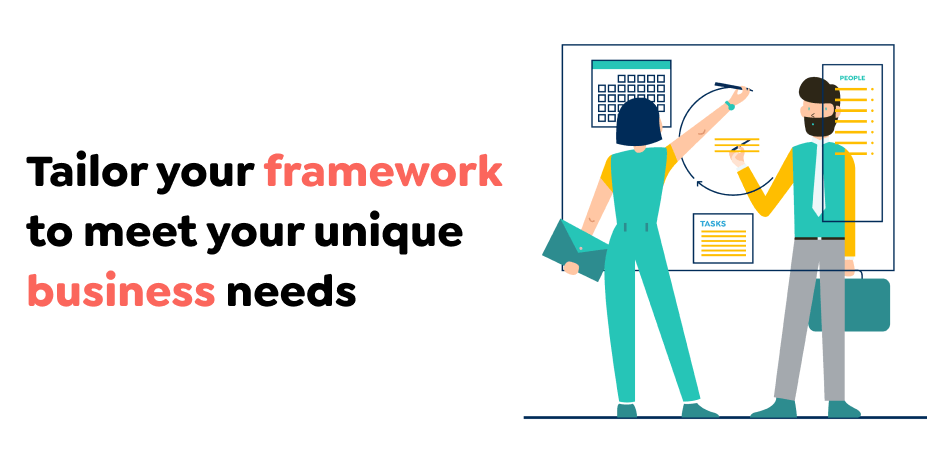
You can blend and match to create a suitable structure to guide digital transformation and your Mobile App Development Company strategies. Let’s look at how to set up the business-specific DX framework.
Also Read – How Much Will Mobile App Development Cost in 2025?
Begin by determining your business’s stage of maturity and then clearly state what you would like to achieve using this digital transformation strategy. This could include improving customer experience and efficiency and entering a new market. Set specific, quantifiable, feasible, achievable, pertinent, and time-bound (SMART) targets to measure progress. Develop a comprehensive plan outlining the actions, timeline, and resources required to complete the change, including important events and delivery items.
When implementing digital transformation strategies, ensure the full participation of the most senior committee members, who are also referred to as stakeholders. Include all employees throughout the planning process to build trust and an attitude of responsibility. Spend money on employee education programs to help them become familiar with the digital transformation efforts and comprehend how to maximize their potential. Encourage a culture of creativity and experimentation. Encourage the culture to adapt to the latest technologies and methods.
In line with your digital transformation needs, check out modern technology that can be seamlessly integrated into the business process. Ensure you implement robust methods for managing your data to guarantee data integrity, security, and accessibility. Choose scalable and adaptable solutions that can evolve and adjust to your needs as a business. Protect your endpoints of all digital solutions from cyberattacks and use advanced AI/ML tools to leverage data and make business processes more efficient.
Create your DX framework to find your processes’ inefficiencies and propose ways to streamline them for improved results. Enhance your digitalization strategy with automated capabilities to automate routine, tiresome tasks and concentrate on more strategic tasks. Combine it with Key Performance Indicators for monitoring processes to find inefficiencies and improve them where needed.
Regularly review and provide feedback cycles for digital transformation projects to ensure that your initiatives are up to date and producing the anticipated benefits. Make room for improvements and additions that can enhance the DX initiatives, and stay up-to-date with new technology and technological trends in digital transformation to ensure your business’s relevance.
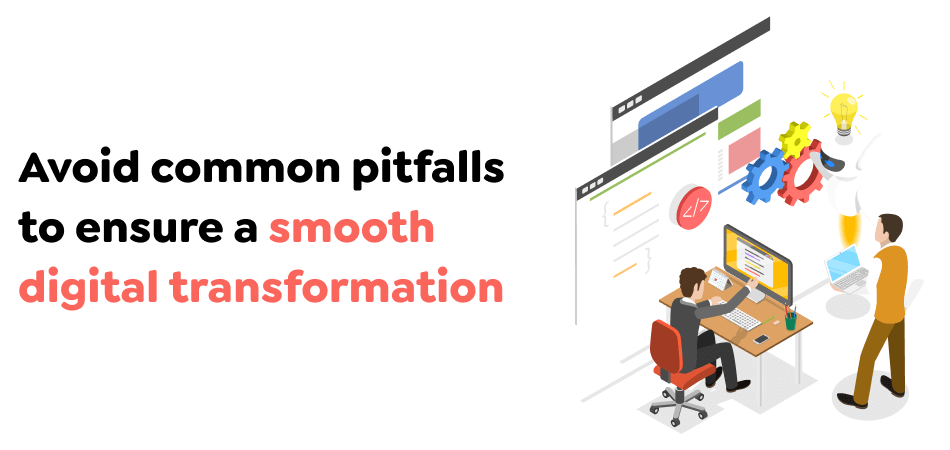
Making a digital transformation framework is crucial for mobile app and web app development, it also provides a plan for success. It is essential to realize that mistakes on this road could result in costly failures and missed opportunities. Understanding and eliminating the pitfalls can ensure a less tense and more efficient transformation process that maximizes your company’s digital capabilities.
When it comes to implementing an approach to digital transformation, most companies concentrate solely on technology. This is because technology is the best-known factor in initiating digital change. While technology is crucial, digital transformations can be a failure when other aspects are not addressed, such as getting employees prepared for, educated about, and on board to embrace the change.
However well-organized your organization’s efforts to transform itself digitally can be, they could fail if the cultural transformation stream in its digital transformation plan has yet to receive enough focus. A company is made up of its employees, and without being able to keep them updated on these changes, the initiative will likely face challenges. Creating programs to foster cultural shifts is vitally important for maximum efficiency in digital transformation processes.
Incorporating your company’s culture and strengthening internal communications is crucial to completing the transformation process successfully. CIOs should ensure that every department works together to carry out initiatives that can adapt to the changing environment.
One of the biggest things that could be improved regarding digital transformation is working within isolation. Even with all the departments working toward a common objective, the strategy will not succeed if the departments are not working together. Silos block insights not being shared and duplication is prevented, and the pace of the pace of progress slows.
The formation of silos is often an outcome of individuals or groups trying to gain control of their workloads and keep it under control amid a significant shift. Digital transformation is a framework designed to bring people together for projects. The transformation of a company will go quicker if this method of working is a part of the corporate culture.
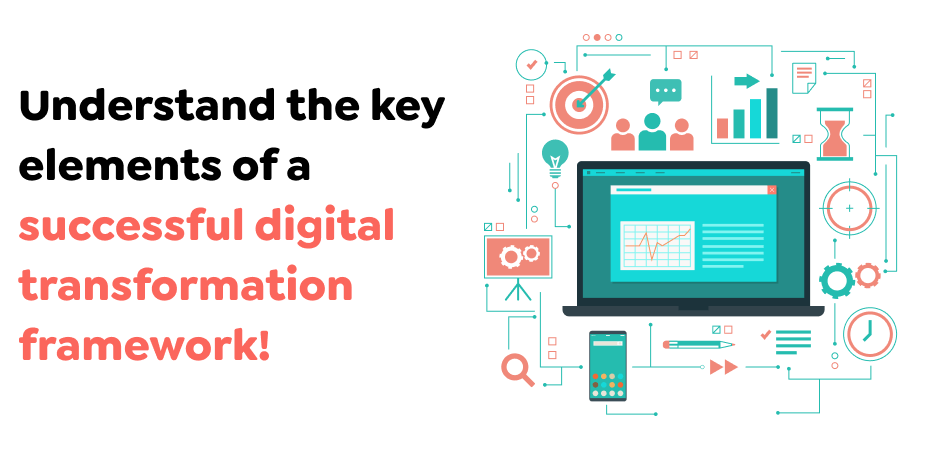
The framework for digital transformation is a tool that can be utilized by a mobile app development company to analyze their digital capability and to develop a plan to enhance their abilities. The framework comprises four significant elements: people, processes, information, technology, and data. Each element comes with its unique list of characteristics and examples. When you understand the digital transformation framework and its main components, organizations can create strategies to enhance their digital abilities.
There are numerous benefits of using the framework of digital transformation. With this framework, companies can handle the process efficiently and effectively while ensuring that everyone involved agrees with the process. Additionally, it enables companies to monitor the progress they are making and verify that they’re achieving the goals they set. The result is that the digital transformation framework could assist companies in increasing their bottom line and being better competitive in today’s digital world.
Get in touch with Techugo to know more about the Frameworks and development process!
Write Us
sales@techugo.comOr fill this form